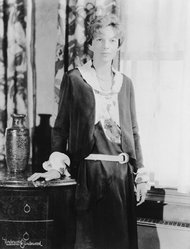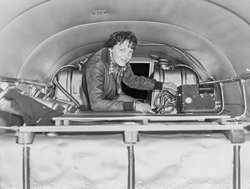Amelia Earhart
|
|
Amelia Mary Earhart (July 24, 1897 - c.July 2, 1937) was a famous American aviator, known for breaking new ground for female pilots, and remembered for her mysterious disappearance during a flight over the Pacific Ocean.
| Contents |
Flying career
Born in Atchison, Kansas, Amelia loved to play with her younger sister, Muriel. This time that they spent together sheltered Amelia from her father and his alcoholism. Because of Edwin Earhart's inability to provide for his family, Amelia spent the first twelve years of her life living with her mother's parents.
Her introduction to aviation occurred at a Kansas state fair when she went up in an airplane piloted by Frank Hawks on December 28, 1920. She later joined her sister Muriel in Toronto, Canada where she worked as a nurse's aide in a military hospital looking after wounded soldiers of World War I. In 1919 she enrolled as a pre-medical student at Columbia University in New York City but after one semester moved to Los Angeles, California where she became interested in flying and began taking lessons from Neta Snook. With financial help from some of her family, in 1922 Earhart bought her first airplane, a Kinner Airstar. After her parents divorced, she sold the plane in 1924 and moved back East, where she was employed as a social worker in Boston, Massachusetts. During this time, she was able to keep up with aviation as a weekend hobbyist. She was even featured in local newspapers while she taught English.
One afternoon in April, 1928, she got a phone call while at work. The man at the other end asked her "Would you like to fly the Atlantic?" She interviewed with the project coordinators, including book publisher and publicist George P. Putnam, and was asked to join pilot Wilmer Stultz and co-pilot/mechanic Louis Gordon. The team left Trepassey Harbor, Newfoundland, in a Fokker F7 on June 17, 1928, and arrived at Burry Port, Wales, United Kingdom approximately 21 hours later. When the crew returned to the States, they were greeted with a ticker-tape parade in New York and a reception held by President Calvin Coolidge at the White House. From then on, flying was the fixture of Earhart's life. She placed third at the Cleveland Women's Air Derby (nicknamed the "Powder Puff Derby" by Will Rogers). She was engaged to Samuel Chapman, an attorney from Boston, but in November of 1928 announced that the engagement had been broken and soon her life began to include George Putnam. The two developed a friendship during preparation for the Atlantic crossing. They were married on February 7, 1931. Earhart referred to the marriage as a "partnership" with "dual control."
Flights
On the morning of May 20, 1932, she took off from Saint John, New Brunswick with a copy of the local newspaper. She then stopped off in Harbour Grace, Newfoundland in her Lockheed Vega, intending to fly to Paris, duplicating Charles Lindbergh's solo flight. However, strong north winds, icy conditions and mechanical problems forced her to land in a pasture near Derry, Northern Ireland, United Kingdom. She received the Distinguished Flying Cross from Congress, the Cross of Knight of the Legion of Honor from the French Government, and the Gold Medal of the National Geographic Society from President Herbert Hoover.On January 11, 1935, Earhart became the first person to fly solo across the Pacific Ocean from Honolulu to Oakland, California. Later that year she soloed from Los Angeles to Mexico City and back to Newark, New Jersey. In July 1936 she took delivery of a Lockheed 10E "Electra," financed by Purdue University, she started planning her round-the-world flight.
Her flight would not be the first to circle the globe, but it would be the longest at 29,000 miles (47,000 km), following an equatorial route. Fred Noonan was chosen as the navigator. He had vast experience in both marine (he was a licensed ship's captain) and flight navigation. He had recently left Pan Am, where he helped establish the company's seaplane routes across the Pacific. He hoped the resulting publicity would help him establish his own navigation school in Florida.
On March 17, 1937 they flew the first leg, Oakland, California to Honolulu, Hawaii. The flight resumed three days later, but a tire blew on takeoff and Earhart ground-looped the plane. Severely damaged, the aircraft had to be shipped to California for repairs, and the flight was called off. The second attempt would begin at Miami, this time to fly from West to East. They departed on June 1, and after numerous stops in South America, Africa, the Indian subcontinent, and Southeast Asia, they arrived at Lae, New Guinea on June 29. About 22,000 miles (35,000 km) of the journey was completed. The remaining 7,000 miles (11,000 km) would all be over the Pacific.
On July 2, 1937, at midnight GMT, Earhart and Noonan took off from Lae. Their intended destination was Howland Island, a flat sliver of land 2000 meters long and 500 meters wide, 10 feet (3 m) high and 2556 miles (4113 km) away. Their last positive position report and sighting were over the Nukumanu Islands, about 800 miles (1,300 km) into the flight. The U.S. Coast Guard cutter USCGC Itasca was on station at Howland, assigned to communicate with Earhart's Lockheed Electra 10E and guide her to the island once she arrived in the vicinity.
Through a series of misunderstandings or errors (the details of which are still controversial), the final approach to Howland using radio navigation was never accomplished, although vocal transmissions by Earhart indicated she and Noonan believed they had reached Howland's charted position, which was incorrect by about five nautical miles (9 km) over scattered clouds. After several hours of frustrating attempts at two-way communications, contact was lost, although subsequent transmissions from the downed Electra may have been received by operators across the Pacific.
Books
Amelia Earhart was an accomplished writer who served as aviation editor for Cosmopolitan magazine from 1928 to 1930. She authored numerous magazine articles and essays, and published two books based upon her experiences as a flyer during her lifetime:
- 20 Hrs., 40 Min. was her journal of her 1928 flight across the Atlantic as a passenger (making her the first woman to make such a journey).
- The Fun of It was a memoir of her flying experiences, as well as an essay on women in aviation.
A third book credited to Earhart, Last Flight, was published following her disappearance and featured journal entries she made in the weeks prior to her final departure from New Guinea. Compiled by Putnam himself, historians have cast doubt upon how much of the book was actually Earhart's original work and how much had been embellished by Putnam.
Search and theories
The United States government spent $4 million looking for Earhart, which made it the most costly and intensive air and sea search in history at that time, organized by the Navy and Coast Guard. Many researchers believe the plane ran out of fuel and Earhart and Noonan ditched at sea. However, one group (TIGHAR - The International Group for Historic Aircraft Recovery) suggests they may have flown along a standard line of position, which Earhart specified in her last transmission received at Howland, to Nikumaroro (then known as Gardner) Island in what is now Kiribati, landed there, and ultimately perished. TIGHAR's research has produced a range of documented, archaeological, and anecdotal evidence (but no proof) supporting this theory.
Over the decades, others have come forward with supposed proof that Earhart was captured in South Pacific Mandate area by the Japanese and interned for a number of years before either perishing or being executed. A photograph supposedly of Earhart during her captivity exists, though skeptics have pointed out that it looks like it was taken at the same time as other photos shot before her final flight. Possibly the strangest suggestion is that Earhart was forced to make propaganda radio broadcasts as one of the many women known as Tokyo Rose.
Yet another school of thought suggests that Earhart later managed to return to America where she changed her name and lived out her life quietly, while another blames her disappearance on Unidentified Flying Objects.
In 2004 explorer David Jourdan announced plans to use sonar to search a 1,000 square mile (2,600 km²) area near Howland Island for Earhart's plane. The ocean where Jourdan plans to search is approximately 5,000 meters (17,000 ft) deep.


